- Open Source CEO by Bill Kerr
- Posts
- CrossFit & The UFC: A Case Study
CrossFit & The UFC: A Case Study
Comparing how leadership led to one meteoric rise, and one precipitous fall. 🍿
👋 Howdy to the 3,143 new legends who joined this week! You are now part of a 186,515 strong tribe outperforming the competition together.
LATEST POSTS 📚
If you’re new, not yet a subscriber, or just plain missed it, here are some of our recent editions.
🪦 Substack Just Committed Creatorcide. A little part of the creator economy was murdered in cold blood recently.
✨ Building AI-Powered Time Management. An interview with Matt Martin, Co-Founder and CEO of Clockwise.
🌐 How Deel Does Global Compensation. An interview with Jessica Pillow, Global Head of Total Rewards at Deel.

PARTNERS 💫
Focus on winning deals, not updating CRM fields.
Building a company is hard enough, and your CRM shouldn’t feel like another job. Clarify updates your pipeline, preps you for meetings, and takes notes so nothing slips through the cracks.
Close more deals without the busywork. Up and running in minutes, free to start.
Interested in sponsoring these emails? See our partnership options here.

HOUSEKEEPING 📨
Very small update from me today. I am lying low, trying to recover from my chronic overtraining episode (I sound like a sook, I know). I found this tweet on the left kinda funny. Although I don’t really drink anymore, I honestly miss it, and I don’t think we do enough of it as a society.
Some of my most hilarious times have come while having a ‘cheeky pint’ as the Brits would call it. I think it’s good for the soul. Having said that, I don’t miss hangovers, and more power to those who are straight-edge and stay that way. What about you, though? Am I crazy? Or am I on to something? |
|
What are your thoughts about how we drink as a society? |

BUSINESS STORY 🗞️
CrossFit & The UFC: A Case Study
Think about survival. Your own survival. If you are dropped into a situation, let’s say it’s a Tom Hanks in Cast Away type deal, where you are stuck on a desert island and have to fend for yourself. What are the two things you may want to have on your side: you want to be strong, and you want to be fit.
Over the last 30 years, CrossFit & the UFC had the chance to dominate those two incredibly powerful ideas. Who is the fittest? And who is the toughest? One of them has executed with Muad'Dib level prescience, determination and intellect. And the other has executed like a turd filled dumpster fire, the likes of which the world has never seen
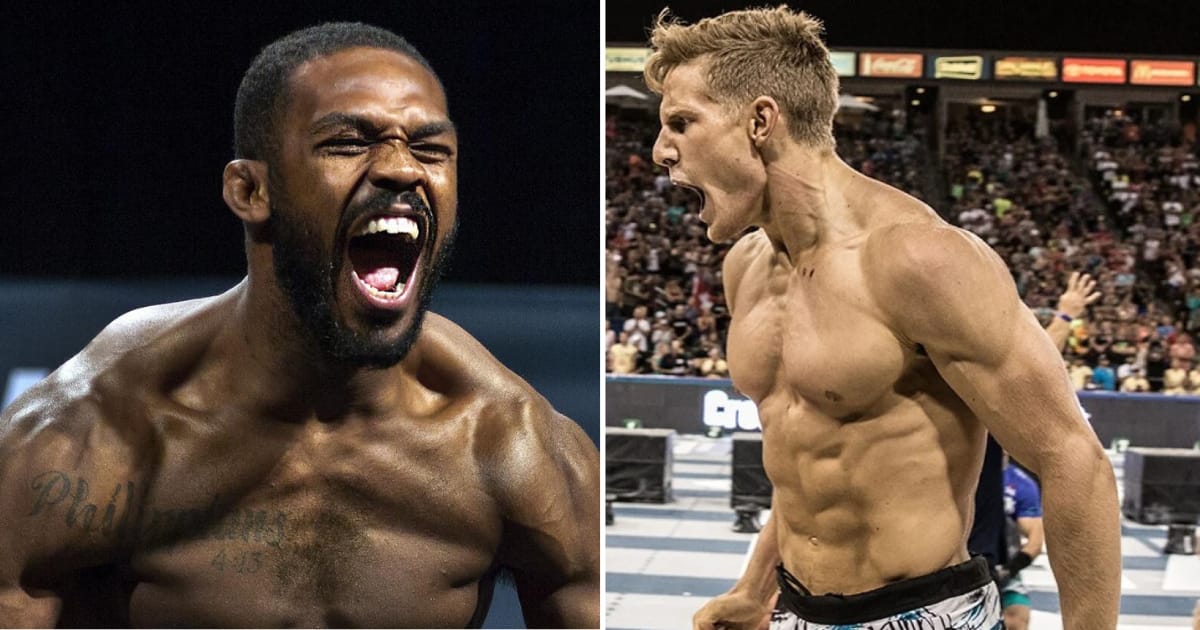
Today I aim to retell the last 30 years. What went well, what went poorly, and how we got to where we are today. At its core, this is a case study in brand, culture and leadership. This is the story of the fall of CrossFit and the rise of the UFC.
Who’s the toughest? Who’s the fittest?
The pursuit of toughness and fitness is as ancient as humanity itself. Long before modern sports, the Greeks celebrated these ideals through the Olympic Games, where events like wrestling and pankration—a brutal mix of boxing and grappling—tested raw strength and resilience. These weren’t just competitions; they were battles to prove one’s dominance and ensure honour for the city-state.
Fast forward a few thousand years, and not much has changed. Whether it’s the gruelling Tour de France, testing human endurance, or the ironman triathlons pushing athletes to their physical and mental limits, the fundamental question remains the same: who can endure, adapt, and excel under the most pressure?
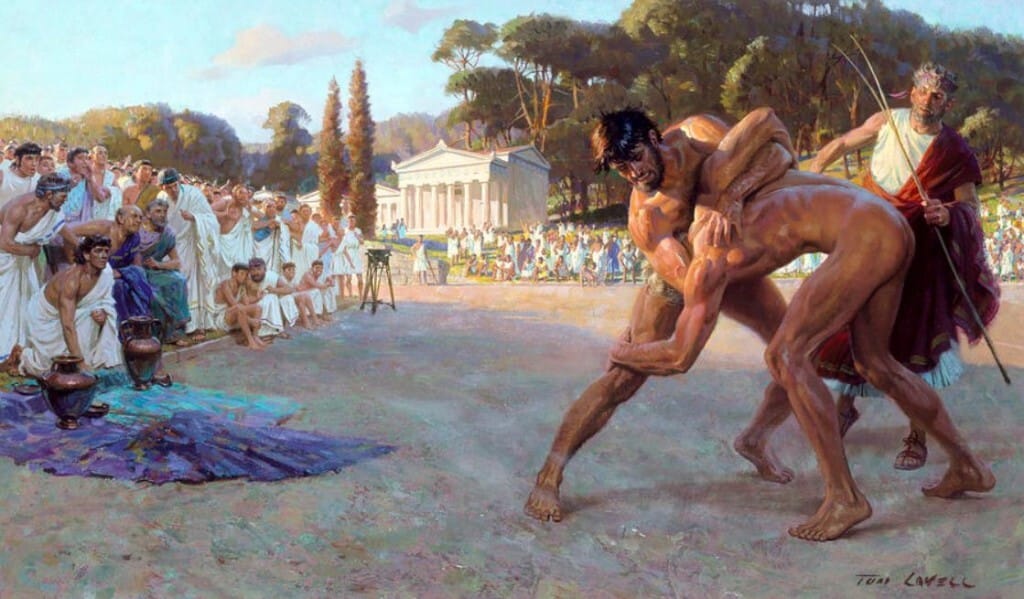
How men used to hang out.
Even today, cultural traditions reflect these same values. In Japan, sumo wrestling is as much a spiritual endeavour as it is a test of physical might. In the NFL, players run head-on, colliding with CTE-enducing force, embodying the long-forgotten premodern gladiatorial toughness. And then there’s the CrossFit Games and the UFC—two modern arenas where toughness and fitness intersect.
These sports tap into something primal. They speak to our innate drive to prove our capabilities—whether to others or to ourselves. CrossFit asks, ‘How fit can you be?’ while the UFC challenges, ‘Can you get punched in the face then get back up?’ Their rises are no accident—they’re tapping into an eternal narrative that resonates as deeply now as it did in the time of the ancient Greeks.
The birth of two sports
What do most sports have in common? Most of them were invented in the 1800s. Tennis, football—whichever type you prefer—baseball, basketball, all 1800s. But it was within a 10-year stretch of time between 1993 and the year of the Y2K Bug that both the UFC and CrossFit were created.
The ‘Ultimate Fighting Championship’ was invented in 1993 by businessman Art Davie and Brazilian martial legend Rorion Gracie. The sport was a lot different to the sport you see today. Sumo wrestlers, jiu jitsu practitioners, karate kids, and even a one-gloved boxer met in Denver, Colorado, to decide who would be crowned ‘The Ultimate Fighter.’
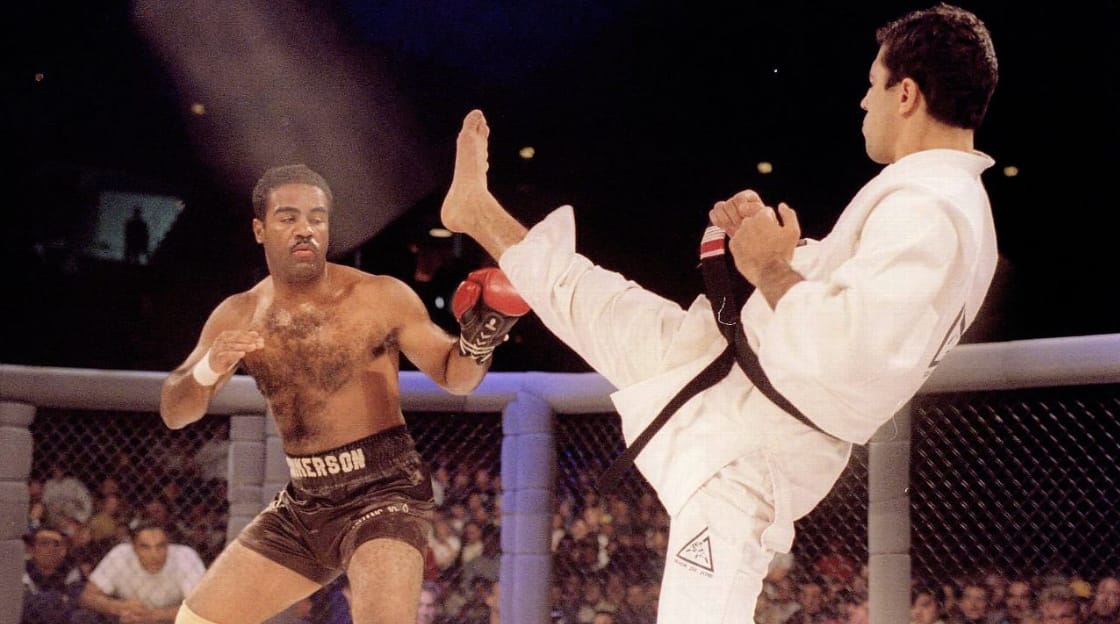
That one glove bad boii.
The sport had a cult following, but was much maligned. Senator John McCain would famously call this cage fighting extravaganza “human cock fighting” in 1996. And you can kinda see why. Before the UFC changed hands at around their 33rd event, there weren’t as many rules as you see today. Headbutts were commonplace, groin strikes were an acceptable way to hurt your opponent.
CrossFit, on the other hand, or as the WOD-lords will tell you, ‘constantly varied functional movements performed at high intensity,’ was born in the year 2000. The brainchild of Lauren Jenai and Greg Glassman.
The sport of fitness, as it is/was, really does improve people’s lives. If you want to jump high, run fast, kick long, lose weight, get jacked—CrossFit can get you there.
 |  |
Both sports faced uphill battles through their early years. The UFC—which was purchased by the Fertitta brothers and Dana White in 2001 from its original founders for $2 million dollars—fought for acceptance by mainstream media, and battled to be sanctioned in states throughout the U.S. CrossFit, on the other hand, battled to be socially acceptable. Not weird, not culty.
But even so, both sports broke ground. The UFC cleaned up its rules, started investing heavily in storytelling, and set about pushing back on the original 36-state ban on ‘no-holds-barred’ fighting. CrossFit boxes, meanwhile, were proliferating like rabbits. Every man and his dog had at least one friend who had chugged a little of that sodium-infused, CrossFit Kool-Aid. Hell, CrossFit even had its own little Olympics, the aptly named CrossFit Games.
Inflection points: one good, one bad
Both sports, through the 2000s, really were starting to cook. But it wasn’t until 2005 that the UFC would really become a household name. One single, solitary punch-up between Forrest Griffin and Stephan Bonnar led to a global explosion of interest in the sport, which is now called ‘mixed martial arts.’
CrossFit, too, was having its time in the sun. The number of affiliated gyms grew quickly in the early 2000s: there were 13 gyms in 2005, 8,000 in 2013, and more than 13,000 in 2016. By 2018, there were around 15,500 CrossFit gyms in 162 countries across the globe. Total converts worldwide have been estimated between two and five million. Even famed coaches like Louie Simmons, John Welbourn, and Bob Harper began working with the brand.
But 2005 was the (positive) inflection point for the UFC, 2016 was the same for the sport of CrossFit, albeit in the other direction. You see, the difference between the two brands was simple: leadership. Dana White and brother Fertitta worked tirelessly to legitimise the sport. They built the brand globally and invested heavily in testing, regulation, and fighter pay.
CrossFit, on the other hand, ostracised its community. Over, and over, and over again. The first incident I remember was one in which the brand posted a strung-up bear on its social media feed.
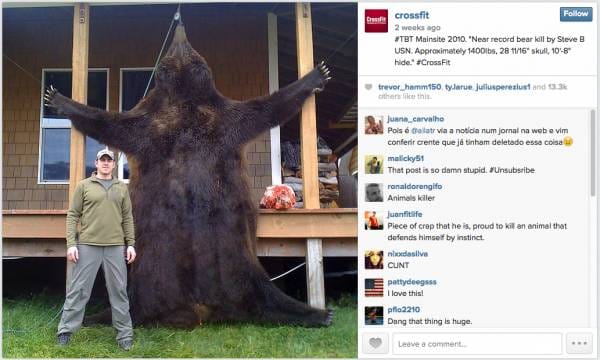
The Revenant, alternate version.
It was not that the post created the fracture within CrossFit, but how the brand handled the aftermath. Russel Berger, of CrossFit HQ, who was managing their social media accounts at the time, decided to troll the community that was upset with the post. I am paraphrasing, but I remember seeing countless puns; 'I am really sorry you cannot bear to see this,’ ‘please BEAR with us while we take the post down,’ etc, etc.
For a company whose business model is licensing out its brand, this is insanity. Berger was fired 3 years later for the following homophobic tweet:
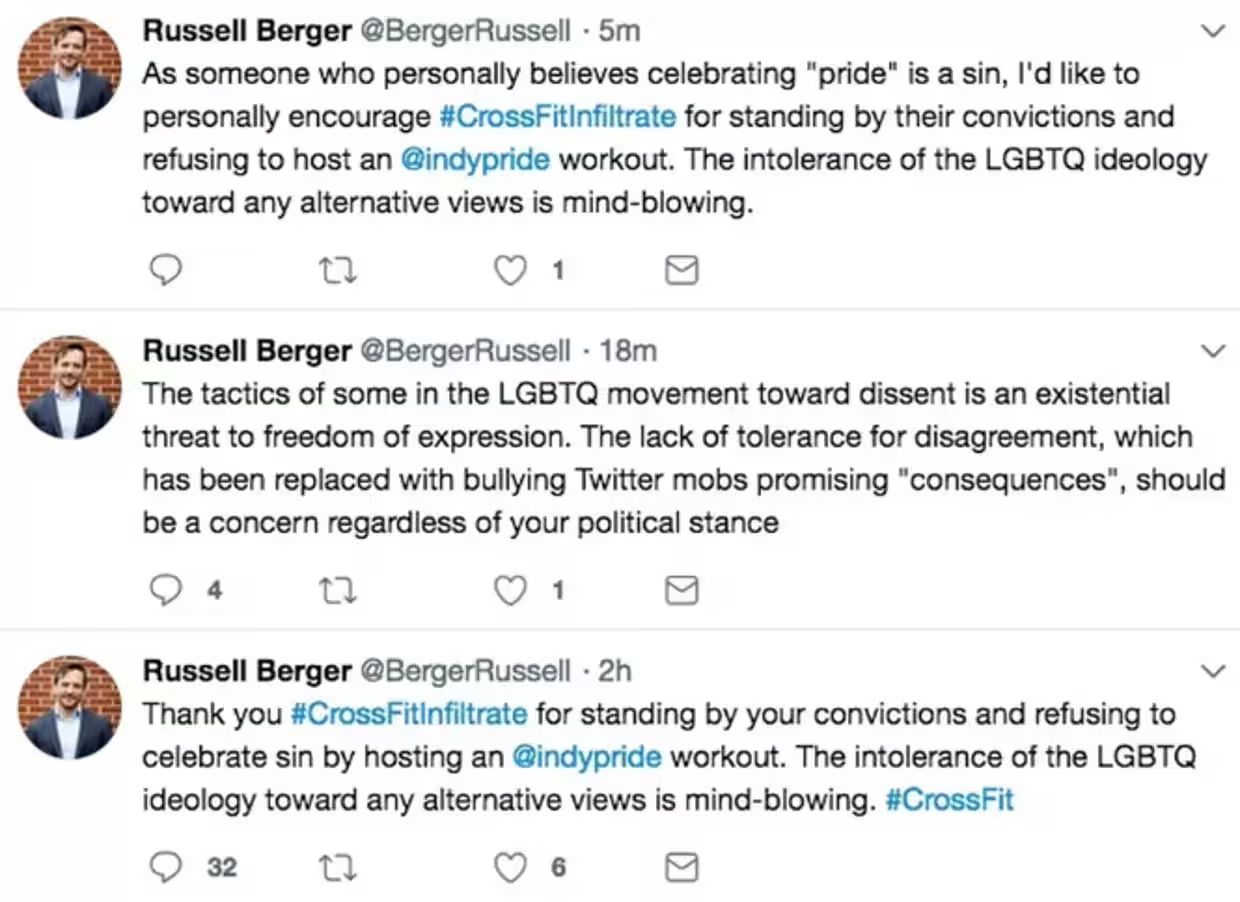
The next erosion of trust in the mid-2010s came when CrossFit announced that it would be giving the winners of the CrossFit Games Glock pistols as part of their prize packs.
Reebok, Crossfit & Glock together. This is not us nor you. Please publicly share your opinion. change.org/p/crossfit-inc…
— Daniel Bartels (@danielbartels)
4:29 AM • Jul 15, 2016
Again, for me, it wasn’t the prize itself—well, it absolutely was, of course, as that’s absurd—but the way they handled it. As soon as they began to receive blowback from sponsors, athletes, and their international community, they responded by having all their leaders and top athletes post videos of shooting guns for multiple days in a row.
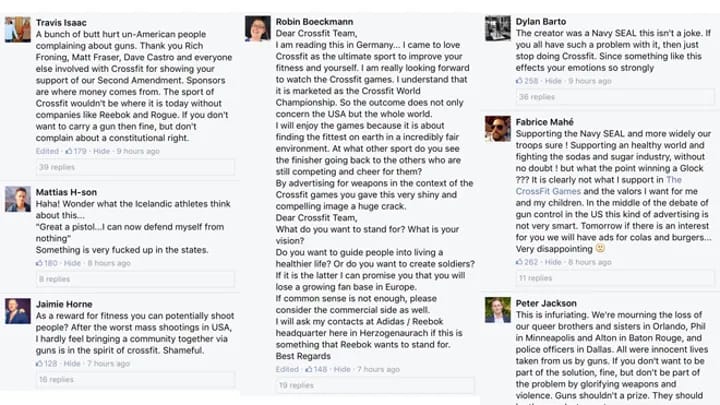
The truth is, these were not isolated incidents. A few months prior to the infamous bear controversy, CrossFit posted images of hunting alligators on their social feeds. Just like clockwork, the community erupted, and then they proceeded to follow up by posting more people hunting gators. Same playbook applied; total disrespect of the community.


Maturity / immaturity vectors
As we got closer to the 2020s, the gulf between the two sports continued to widen. Dave Castro, one of the most reviled frontmen in any sport, continued to lower the prestige of the sport of CrossFit, while Dana White and the UFC continued to show global leadership.
*I am going to stop here to make a quick note that Dana White, too, is a flawed human. I am not going to pretend that a couple of years ago, footage didn’t surface of him hitting his wife during a family holiday.
 CrossFit’s Dave Castro. |  UFC’s Dana White. |
The paths of sports would converge in the news in 2020, all within a handful of weeks. It was June of 2020 that CrossFit founder Greg Glassman was forced to resign after he mocked the death of George Floyd, leading to CrossFit losing their major sponsors, and having thousands of gyms un-affiliate with the brand.
One month later, the UFC was renting an island in Dubai during the middle of the COVID-19 pandemic, showing that sport can live on if coordinated in a professional, well-executed manner. The UFC’s ‘Fight Island’ event went down flawlessly and was the first of the major sports to show that events can, in fact, be done safely.

Fight Island.
The UFC continued to shine brighter, but things would continue to get worse for CrossFit. Following his resignation, reports surfaced detailing a toxic workplace culture under Glassman's leadership, including allegations of routine and rampant sexual harassment. Incidents reported involved lewd comments and inappropriate behavior towards female employees. Notably, in 2012, Glassman settled a potential sexual harassment lawsuit with a former employee, Julie Kelly.
UFC’s crowning achievements, CrossFit final blow
In 2008, Dana White said the following: "Remember that I told you this: in the next five to eight years, this thing’s going to be the biggest sport in the world—bigger than the NFL, bigger than soccer, bigger than anything else out there." When he made this statement, no one believed him. But no one would laugh at that statement in 2025. The UFC sold itself at a 2000x markup from its $2 million purchase price in 2016, and Dana White sits on the board of Meta alongside Mark Zuckerberg as of today.

Source: NY Times.
Whether you are a left-leaning creative hippy or a right-leaning capitalist pig, you can appreciate the cultural significance of today’s UFC. The first outing Trump made after his felony conviction was a visit to a UFC event. Trump, flanked by both Elon Musk and Kid Rock of all people, made a grand entrance to the recent UFC 302 event.
Donald Trump just made his famous entrance with Dana White at UFC 302 👀
— Happy Punch (@HappyPunch)
2:03 AM • Jun 2, 2024
While the UFC continues to grow by leaps and bounds, CrossFit reached its lowest ebb at last year’s CrossFit Games, with the unfortunate drowning of one of the athletes. Lazar Đukić, a 28-year-old athlete from Serbia, showed signs of distress about 50 meters from the finish line of a swim event before going under, with the body being recovered approximately one hour later.
The ultimate disgrace
Shortly after the drowning, Glassman, the CrossFit founder and one-time guru, would go on a podcast to discuss the event. He would go on to say, and I quote:
“What I would have done when what’s-his-face drowned, sorry about that one, everyone, what a bummer.”
“We will build a little bronze bust of this fucking guy. You know what the athletes would have said; FUCK HIM.”
“Shut the games down for this fuck? He’s Croatian, you idiot.” (He’s Serbian)
This is the first time I’ve been upset while writing this newsletter. It’s hard to put into words what I think of this guy. It’s funny to look back on my experience with CrossFit, though. A decade earlier, when I was part of the CrossFit community—from 2012 to around 2016—I would refer to myself as a ‘strength and conditioning coach,’ rather than a ‘CrossFit coach,’ because I was embarrassed to be associated with the brand that Glassman and his team had built.
Insights to take away
Leadership defines success: Strong leadership, like Dana White’s, can legitimise a brand, while missteps, such as those of CrossFit’s Greg Glassman and team, can erode trust and community.
Community is everything: CrossFit’s repeated disregard for its community highlights the damaging effects of alienating one's core audience. Building and maintaining trust is paramount.
Adapt or die: The UFC thrived because it adapted—cleaning up its rules, investing in storytelling, and aligning with broader societal norms. CrossFit faltered by clinging to insular attitudes.
Crisis management matters: How brands handle backlash can define their future. The UFC faced challenges and rose stronger, while CrossFit stumbled repeatedly by doubling down on divisive behavior.
Vision is a multiplier: A bold, cohesive vision can elevate a brand to global recognition. The UFC had it; CrossFit lost it.
Summary / Future
My goal for today’s post was to highlight what professional leadership looks like, and what it doesn’t. And I hope I was able to do that to some extent. What I still find crazy, though, is how badly CrossFit really fumbled the bag. I know that there is an alternate universe in which Dana and his pals bought CrossFit, and the sport of fitness, not the UFC, is the biggest sport in the world today.

Existing in that same universe is a UFC that never got sanctioned, never made it to ESPN, and ultimately never amounted to anything because it was run by people like Berger, Castro and Glassman. For MMA fans, they are glad that this alternate reality is nothing but just that, a fiction. But for all those who take a knee to pray at the altar of CrossFit, this alternate reality is the ultimate one that got away.
Extra reading
Why CrossFit devotees leaving the brand behind is such a big deal - June, 2020
Does CrossFit have a future - July, 2021
Blood sport: how Dana White turned the UFC into a $4bn titan - September, 2022
And that's it! You can follow me on Twitter and LinkedIn, and also don’t forget to check out Athyna while you’re at it.

HIRING ZONE 👀
Yep, this tweet is correct. Athyna and I will be offering a $15k hiring credit to anyone who reaches out to hire AI engineers or any similar AI and ML-related talent. Let’s GO!
First three people to text me to kick off a search for AI engineers I'll give $15k of hiring credits.
— Bill Kerr (@bill_kerrrrr)
1:00 PM • Oct 1, 2025

BRAIN FOOD 🧠

TWEETS OF THE WEEK 🐣
I love this visual so much
— Aadit Sheth (@aaditsh)
6:27 PM • Sep 23, 2025
the current AI industry revenue breakdown
— Trung Phan (@TrungTPhan)
10:23 PM • Sep 29, 2025
Sorry I can't today, I'm absolutely swamped.
— Bill Kerr (@bill_kerrrrr)
1:00 PM • Sep 30, 2025

TOOLS WE LIKE 🛠️
Every week, we highlight tools we like and those we actually use inside our business and give them an honest review. Today, we are highlighting Superpower*—a tool used by founders, leaders, athletes and more to optimise their health using AI.
See the full set of tools we use inside of Athyna & Open Source CEO here.

HOW I CAN HELP 🥳
P.S. Want to work together?
Hiring global talent: If you’re hiring tech, business or ops talent and want to do it 80% less, check out my startup, Athyna. 🌏
Want to see my tech stack: See our suite of tools & resources for both this newsletter and Athyna here. 🧰
Reach an audience of tech leaders: Advertise with us if you want to get in front of founders, investors and leaders in tech. 👀
 |
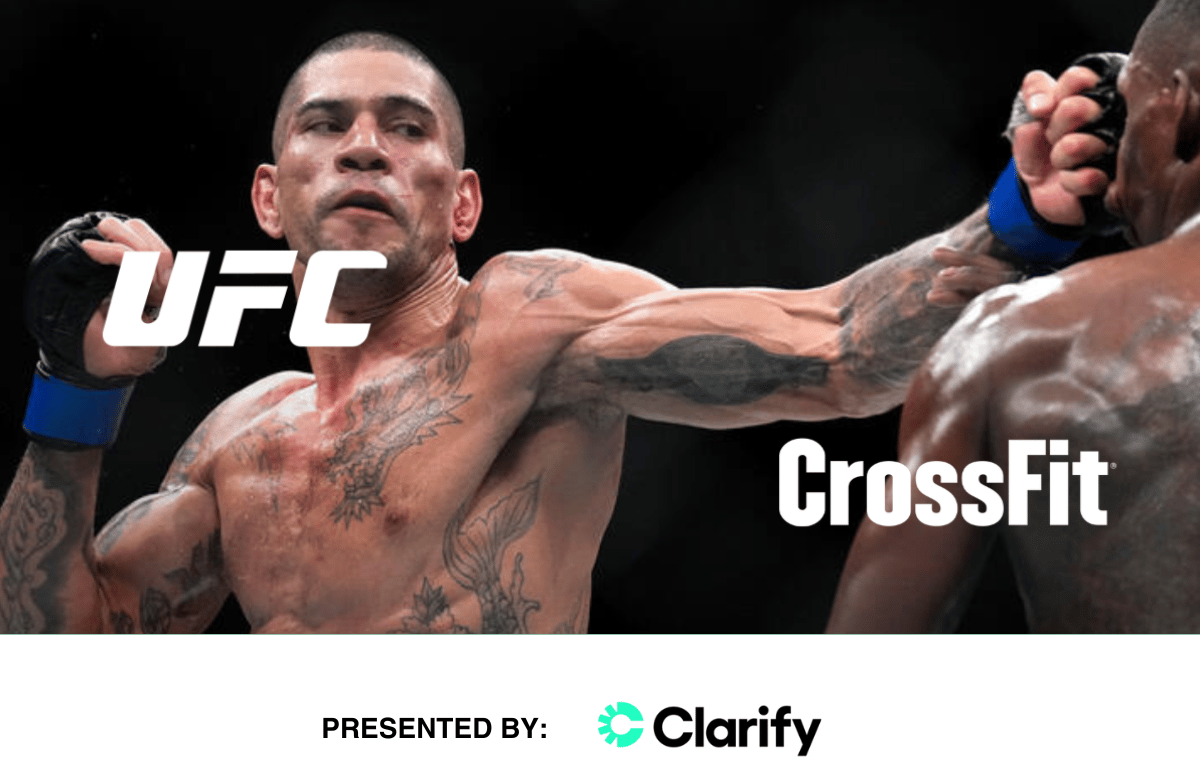
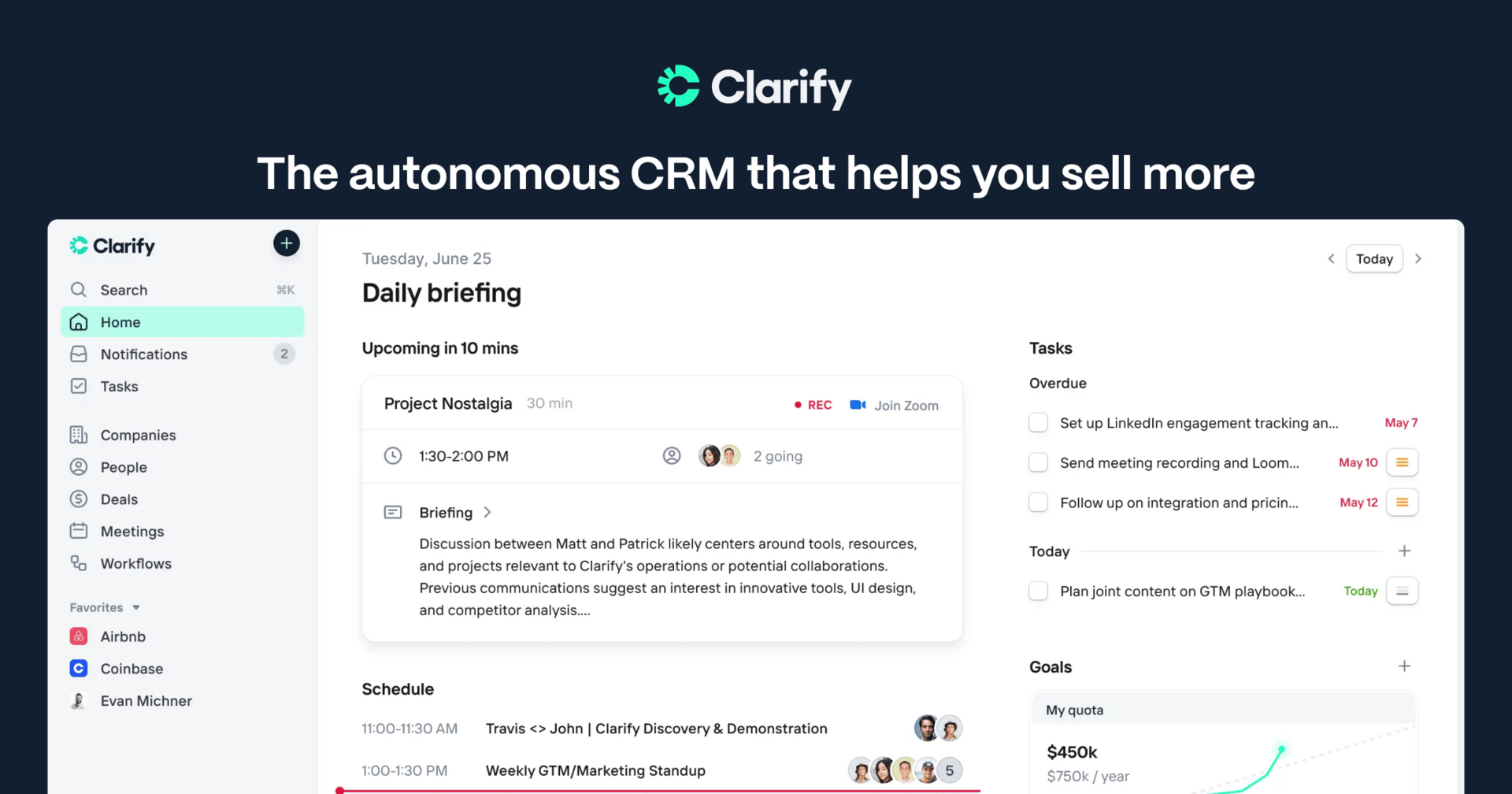


Reply